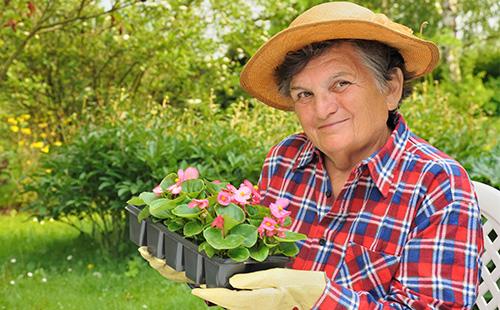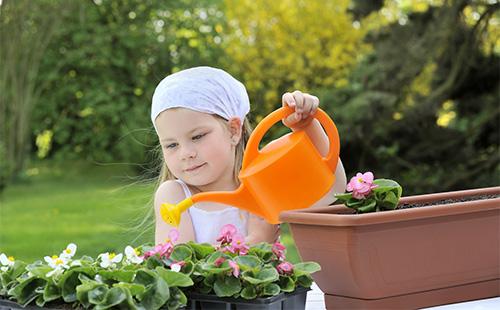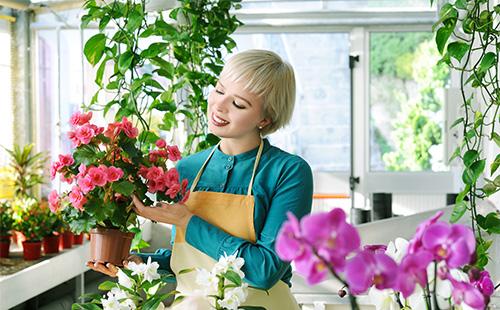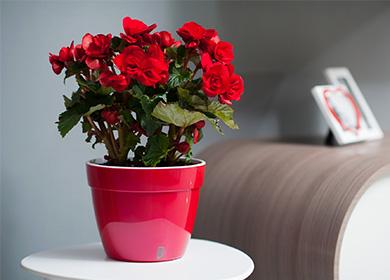The content of the article
- 1 Botanical Description
- 2 Home breeding species
- 3 What to look for when buying
- 4 Home Adaptation: 4 Rules
- 5 Begonia care: 5 recommendations
- 6 Why there are no flowers and how to fix it
- 7 We transplant correctly
- 8 Breeding
- 9 Diseases, pests and other problems. Let's analyze step by step
- 10 "Begonia capriciousness is a myth!", - reviews and advice from the owners
This flower comes from the Antilles. The flowering plant was found and described in 1687 by the botanist Charles Plumier, but the name of the plant was in honor of Michel Begon. It was he who organized the expedition to the islands and invited the French botanist to join her.
The plant loves a tropical and subtropical climate. The ideal place is wet, shady. You can find it in nature in moist forests, on rocks near the sea. Where wild begonia doesn't grow - in Africa, Asia. But even in Europe, the plant managed to take root, and all thanks to the unique ability to adapt to new conditions. Root begonia wilt, what to do with it in the winter?
Botanical Description
Begonias are annual and perennial. Among this species, there are herbaceous plants and huge shrubs. There are flowering begonias (even those that bloom all year round!), And there are decorative leafy ones. Rhizome may be creeping or thickened. In a word, it is difficult to distinguish characteristic features: begonias differ from each other both in the forms, and color of leaves and flowers, in height. But nevertheless this family has “identification marks”.
- Leaves. For all species, the leaf is oblique, asymmetric. This is the "calling card" of the flower. Leaves can be whole, cut into segments, with wavy edges and serrations. The outer part of the sheet is painted in green shades (from light to saturated dark), and the lower part is dark purple, reddish, brown. In some species on the leaves you can see blotches, geometric patterns, villi.
- Flowers Plain, with brightly colored perianth. The color may be different. Most often, indoor plants with white, pink, yellow, red flowers are found. Unusually look flowers with a fringing on the petals.
- Fetus. If the inflorescences are not removed, then the fruit will appear in the form of a box. There are seeds in it. In nature, begonia multiplies by them: the ripened fruit cracks, the seeds carry the wind.
Home breeding species
In nature, there are about 800 species of begonias. Another 2 thousand varieties managed to be bred. All varieties are described in specialized reference books. But a beginner grower is not so much interested in dry information, but in the answer to the question, which species is better to buy for a home. Tuberous plants are ideal for decorating the landscape and vertical landscaping. They "leave" for the winter.For the home, it is better to choose unpretentious hybrids of root begonias. Conventionally, begonias can be divided into two groups.
- Decorative blooming. Varieties from this group are the "favorites" of gardeners. They are unpretentious and grateful: if the care of begonia is correct, it can bloom on the windowsill almost all year round. The best option for beginner gardeners is the Begonia semperflorens (Everblooming) variety. The lush bush is covered with flowers 12 months a year. In summer, this kind can even be planted in a flower bed, and with the onset of cold weather it can again be returned to the windowsill. But planting in open land is an optional condition.
- Decorative foliage. Although plants of this species cannot boast of beautiful flowers, for which everyone loves begonia so much, they look no less luxurious than flowering ones. Large, bright, with a bizarre pattern of leaves - this is the "highlight" of this species. Experienced flower growers recommend starting to get acquainted with the decorative-leafy varieties with Begonia rex ("Royal"). For all its truly royal beauty, plants of this variety are so unpretentious that even a person far from floriculture will be able to grow an object of pride on his windowsill. But the truth is proud of it: the leaves of the Rex begonia are so original as if they were decorated by an artist, connecting all their imagination.
What to look for when buying
For a long time peered at begonias on the shelves of flower shops and finally decided to get a "beauty"? Choose your flower carefully! It is important to buy a healthy plant, then it will delight you for a long time.
Carefully inspect the leaves: they should be resilient, without spots. Carefully turn the leaves over and check for insects, cobwebs. Experienced flower growers recommend choosing specimens with half-opened buds: a tropical guest will get used to the new house and will appreciate the lush flowering, while a flowering plant can reset the inflorescences from a change of scenery.
Have you decided to grow begonia from a tuber? Choose small and resilient. If there are brown spots, it is better to refuse the purchase: they indicate inappropriate storage conditions.
Home Adaptation: 4 Rules
Caring for begonia after a purchase has some nuances. Inexperienced flower growers, not knowing about them, make mistakes that can lead to the death of the "pet". So myths appear that window sills are not suitable for tropical flowers (including begonias). If you follow the four rules, the plant will appreciate the rapid growth and lush flowering.
- Choose a place. The flower in the new house or not depends on the right place. If begonia appeared in the apartment in the autumn-winter period, it is better to put the pot on the west or east window. Have bought begonia in spring or summer - put it on a windowsill facing north. Leaves turn yellow under the scorching sun of a plant that has entered the house from the greenhouse. Drafts are especially dangerous during the acclimatization period: try to exclude them.
- Do not water. The first five days after purchase you do not need to water. Let the plant adapt to new conditions. If you are afraid that the flower will lack moisture, put a container of water near the flowerpot. When the adaptation time has passed, evaluate the state of the earth coma: if it has dried up, then water it.
- Do not transplant. Immediately after the purchase, a tropical beauty should not be transplanted. Especially if she got into the house already blooming. An emergency transplant is necessary only when it is clear that the flower is flooded or the condition of the soil in the pot is in doubt.
- We comply with quarantine. It is important to wait two weeks for quarantine and only then put a new plant in your window sill. Quarantine has two goals. First: do not infect old plants if begonia “brought” insects to the house. Second: to prevent infection of begonia itself, for which “moving” is stressful - a weakened plant will not cope with new difficulties.
Begonia care: 5 recommendations
How to care for begonias in a pot? Everything is extremely simple: you only need to remember the five rules, and you will get a reason for pride.
- Lighting. Begonia is a photophilous plant. To grow well, you need to provide a lot of light. But direct sunlight can leave burns on the leaves: shade the plant in the summer. When choosing a place for a flowerpot, keep in mind that decorative-deciduous species necessarily need diffused light.
- Temperature. Begonia does not like heat, but it can also wither away from the cold. In the spring and summer, the optimum temperature is 22ºC. In autumn and winter, it is permissible that the thermometer scale drops to 15 ° C, and may not survive below begonia. Do not allow a sharp change in temperature, make sure that the transition from heat to cold and vice versa is gradual.
- Watering. Begonia should be watered with an eye on the season. In summer, watering is carried out approximately once every three days. If the flowerpot is on the sunny side, then daily watering may be required. In the cold season, watering is reduced. The main landmark is the state of the earth coma. It is best to water the soil by impregnation: put the pot in a container of water and hold until the soil is soaked. A prerequisite is that the water must be preliminarily softened: it is defended, filtered.
- Humidity. Do not forget that the homeland of begonia is the tropics, the air is humid there. To make the plant comfortable on the windowsill, the air humidity in the room should not fall below 60%. If the air in the apartment is dry, pour gravel or expanded clay into the pan, moisten it. It is not worth spraying the plant: brown spots appear on the leaves from contact with water.
- Top dressing. When the budding period begins, you need to feed begonia for abundant flowering. It is better to use weak complex formulations. Feeding is continued until the plant fades. Complex fertilizer is suitable only for decorative flowering species, it is applied twice a month. Decorative-deciduous representatives of the family are recommended to be fed with compounds containing nitrogen. He is responsible for the development of deciduous mass. If nitrogen fertilizing is offered in blooming begonias, then, as evidenced by the reviews of gardeners, it will lose buds or will not bloom, even if it was going to.

Why there are no flowers and how to fix it
Florists are especially fond of those types of begonias that for a long time delight with a lush cloud of flowers. A flowering plant transforms the interior, creating a special energy in the room. When does indoor begonia bloom? Most of the decorative-flowering indoor plants bloom in the early to mid-spring and fade only with the onset of cold weather. In addition, there are ever-flowering varieties, and there are those that bloom only in the winter (grade "Elator").
The reasons
Butonov “girlish beauty” owners are waiting with bated breath. But the tropical guest is not always in a hurry to please the owners of the house: sometimes it is impossible to achieve flowering from her.To correct the situation, you need to understand why begonia does not bloom. This is mainly due to care errors:
- not enough light;
- waterlogging of the soil;
- irregular watering;
- too high or low temperature;
- lack of nutrients;
- an excess of fertilizing.
A weakened plant will not bloom, it simply does not have the strength to do so. Therefore, if the "girlish beauty" does not bloom, check it for insects. Weakens the plant and lack of peace: most species require a three-month rest. Perhaps begonias are not suitable for soil, water or a flowerpot, it stands in a draft, often moves from place to place - absolutely any nuance can affect the flowering process.
Flowering Stimulation: The Secret Method
They filled the “gaps”, created an ideal climate, but the begonia never bloomed? Take advantage of a secret that only experienced flower growers know about. The reception is called “short daylight hours” and is held in four stages. This life hack can also be used if the begonia blooms “on schedule”, but quickly fades. After playing with light, the “girlish beauty” blooms profusely and continuously.
- Pinch. It is important that at this time begonia does not grow in height. Otherwise, all the forces will go to growth, and you need to direct them to flowering. To avoid this, pinch the plant. Enough two to three times.
- Reduce the light. Cover the plant with a black film, thereby reducing the daylight hours to nine hours. They play with light daily for two weeks. This activates the buds tab.
- We feed. Feed begonia with a special complex fertilizer.
- We increase daylight hours. Double the daylight hours. If necessary, additionally highlight.

We transplant correctly
Begonia is transplanted when the flowerpot becomes small, if the soil is in doubt, after overflow and to stimulate flowering. A tropical plant needs loose, breathable soil so that the water does not stagnate and the roots do not rot. The composition of the soil is difficult to choose on your own, especially for beginner gardeners. Buy a better specialized substrate in the store. Moreover, each species needs its own soil - with a certain acidity.
What is required:
- drainage;
- priming;
- a pot with drainage holes and a tray.
Instruction manual
- Take the pot about 3 cm wider than the one in which begonia grows.
- Put drainage on the bottom. Layer - not less than 2 cm.
- Remove the plant from the old flowerpot. Carefully clear the roots of old soil.
- Install in a new pot, cover with a store substrate.
Breeding
There are four ways of propagation of plants of the begonia family: cuttings, leaves, tubers, seeds. Florists recommend obtaining shoots by propagating begonias or growing sprouts from leaves. Reproduction by tubers may not be successful. If you do not know how to carry out the manipulation, then you can lose the whole plant. Is it worth the risk if tuberous species can also be propagated by cuttings or leaf method?
Growing a plant from seeds is not the best solution. When vegetative propagation is available, the choice in favor of the seed method seems illogical. This method is relevant only if you bought seeds of some rare variety. In other cases, it is better not to use seed germination - for a long time and not always efficiently.
Cuttings
- Cut off the top of the plant. You should get a stalk with a length of 6 to 10 cm.
- Plant the stalk in a container with moist, loose soil.
- Cover with a jar and wait for the stalk to take root and grow. This takes an average of three weeks.
- Do not forget to pour water into the pan all this time. Be guided by the drying of the soil.
- When the stalk grows up, begin to accustom it to room conditions - open the jar and leave it for a while to “breathe”.
- The next stage is the planting of a new plant.
Leaf
- Take a sharp knife, cut the leaf from the stalk. Preview the leaf: it must be healthy.
- Pour filtered water into a glass, dissolve a pre-crushed tablet of activated carbon.
- Put the sheet in water. Keep an eye on it: if the petiole rots, cut it off, without sparing, to the healthy part, change the water.
- Saw that roots have formed - plant. The new plant will grow - the leaf will dry.

Diseases, pests and other problems. Let's analyze step by step
Florists when growing begonias often encounter the fact that the flower becomes inconspicuous, loses leaves, begins to dry. It is important to understand why home begonia disappears in order to eliminate the cause and help the plant. Mostly flower diseases are caused by improper care. If the case is not running, then solving the problem is simple: you need to optimize watering, adjust the indoor climate. Pests can also settle in the flowerpot, which during the course of their life activity kill the plant. You can determine the cause of the problem by the characteristic signs from the table.
Table - Problems in growing begonias and their causes
| Problem | Cause |
|---|---|
| Begonia leaves dry around the edges | - Vascular bacteriosis; - wrong watering |
| Dropping leaves and buds | - Too dry air; - drying of an earthen coma |
| White plaque on the leaves | - Powdery mildew (develops if the room has high temperature and dry air) |
| Gray spots on the leaves | - Gray rot |
| Leaves twist | - lack of moisture; - dry air |
| Pale sheet | - lack of light |
| Shiny and sticky leaves. | - Shield |
| Leaves turn yellow, dry out | - Spider mite (if the spider line differs from the back side); - lack of nutrients |
| Darken, buds and flowers fall | - overflow; - water got on the inflorescences |
If you notice insects on the plant, then treatment should be carried out immediately. For this, insecticides are used. They are sold in flower shops. Use the preparations according to the instructions on the packaging: do not overdo it with the treatment.
Growing begonias at home may seem difficult only for beginner growers, experienced know how to please the beauty. Begonia not only decorates the house, but also creates an optimal microclimate in it. It is proved that the plant is able to clean the air of bacteria, stop the growth of molds. Interestingly, with the appearance of begonias in the house, cleaning will be less necessary: the plant prevents dust from settling. Is there no reason to look at the nearest flower shop for a lushly blooming beauty? The basics of successful care can be seen in the video and photo.
"Begonia capriciousness is a myth!", - reviews and advice from the owners
My begonia stood for a couple of months, during which time I carefully transplanted it.I specially chose a pot with a diameter of 2-3 cm larger than the previous one. Like most flowering plants, begonia will stop or will not bloom if placed in an oversized pot. Also, for good flowering, it is necessary to remove wilted (dried) flowers.
I chose the soil specifically for flowering plants. There are many such primers from various manufacturers.
I noticed that the soil dries very quickly. I watered a flower in the evening or early in the morning, before going to work, I came - the land is already dry. True, the heat was terrible. There was no one to shade the flower (I did this only on the weekend, and even then, if I didn’t leave anywhere). As a result, from dry air (in spite of my regular spraying, which is not recommended, but it is difficult for me to make the air moist in another way) and from the sun, the leaves of my flower began to look not perfect.
Alyona, http://otzovik.com/review_3726240.html
She asked me somehow to give me on March 8 not a standard bouquet, but a flower in a pot. To be capricious and easy to care for. They gave begonia elatior. It blooms almost all year round, with orange flowers, such a variety. VERY BEAUTIFUL, water it moderately, and if you forget to water it, I think it's okay, the main thing is not to pour it. Propagated by processes is also easy. In general, I am very pleased with my begonia, by the way, it is practically in a draft, and it blooms and grows well. It is sometimes possible to feed for better flowering, and so the plant is excellent! BEAUTY))
Lo-li http://irecommend.ru/content/neprikhotlivaya-i-krasivayafoto
I would not call this beauty too capricious, but watering is the main thing, due to which the flower survives. Our begonia loves water. We water it exclusively through the pan in which the pot stands. Watering is almost daily. If the next day it’s still wet in the pan, I don’t water the flower. During the heating season, there was hellish heat on the windowsill, and every day I humidified the air near the begonia: I took an ordinary spray gun and sprayed around the flower, but in no case on the flower itself. I will do the same in the summer. Try not to put the begonia in too dark, or in too light a place with direct rays. He needs a "middle ground", otherwise the flowers will die quickly. In my flower, I noticed that it reaches for the sun, so from time to time I turn it so that the bush grows evenly.
Dia_Dia_Di, http://irecommend.ru/content/rokovaya-krasotka-porazhaet-svoei-krasotoi-raduet-s-kazhdym-dnem-mnogo-foto-i-sovety

